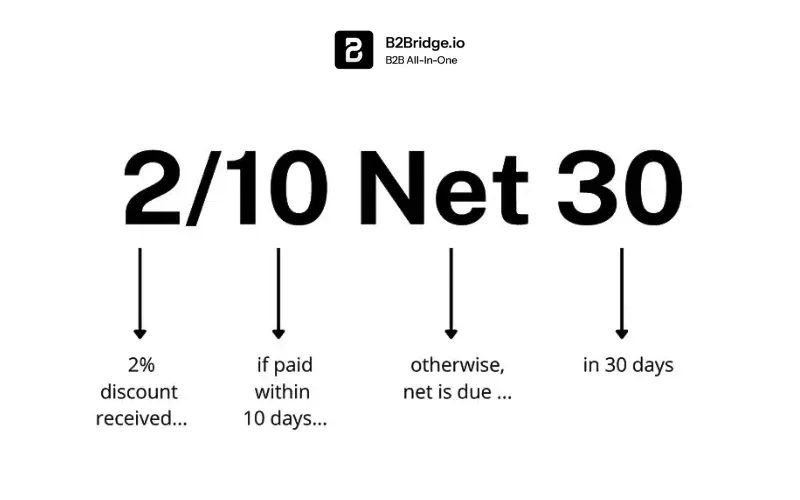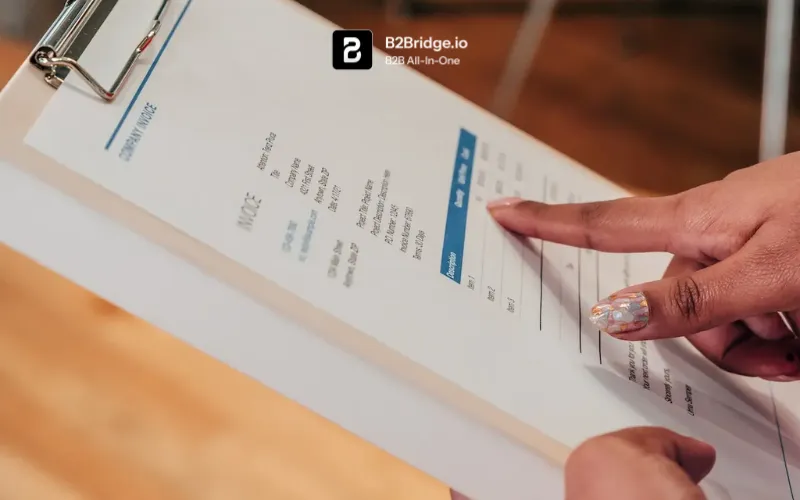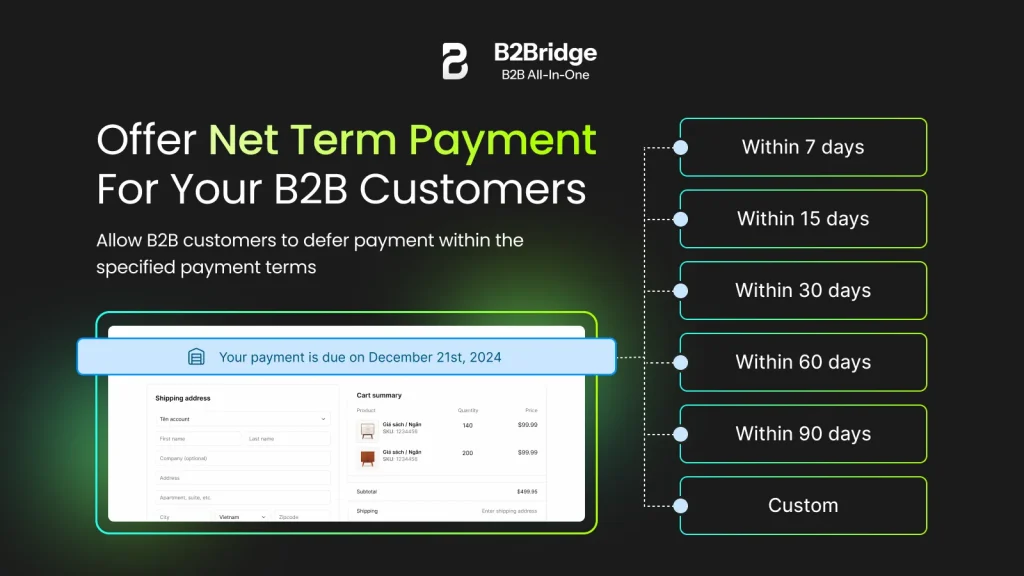Net 30 payment terms mean that a customer has 30 calendar days from the date of the invoice to pay the full invoice amount. It is a common business-to-business (B2B) credit term that essentially gives the buyer 30 days of interest-free credit for goods or services received.
In the world of B2B commerce, managing cash flow effectively can make or break a business. One of the most common payment arrangements that helps businesses balance relationships with financial stability is net 30 payment terms.
In this comprehensive guide, we’ll explore everything you need to know about net 30 payment terms:
- What are net 30 payment terms?
- How net 30 payment terms work
- Benefits of using net 30 payment terms
- How to calculate net 30 payment terms
- Best practices to manage net 30 payment terms effectively
By the end, you’ll have expert-level knowledge to implement net 30 terms that strengthen your business relationships while protecting your bottom line.
What Are Net 30 Payment Terms?
Net 30 payment terms refer to a credit arrangement where a buyer must pay the full invoice amount within 30 days of a specified trigger date – typically the invoice date or shipment date. The “net” indicates that the full amount is due without any deductions, while “30” represents the number of days allowed for payment.

When Does the 30-Day Countdown Begin?
The starting point of the net 30 period is crucial and should always be clearly stated on your invoice. Common triggers include:
- Invoice Date: The most standard approach, where the 30-day period begins on the date the invoice is issued
- Shipment Date: Sometimes used in logistics-heavy industries, starting the countdown when goods leave the warehouse
- Receipt Date: Less common, but occasionally used when the period begins upon delivery confirmation
For example, if you issue an invoice dated October 1st with net 30 terms based on the invoice date, payment would be due by October 31st. This clarity prevents disputes and ensures both parties understand their obligations.
Typical Usage Scenarios in B2B Commerce
Net 30 payment terms are particularly prevalent in:
- Wholesale and distribution: Retailers purchasing inventory from manufacturers or wholesalers
- Professional services: Agencies billing clients for consulting, marketing, or legal services
- Manufacturing: Suppliers providing raw materials or components to production facilities
- Construction: Subcontractors and material suppliers working on project-based agreements
These terms create a predictable payment cycle that helps businesses plan their cash flow while maintaining positive vendor relationships.
How Net 30 Differs from Similar Payment Terms
Understanding the variations helps you choose the right terms for your business:
- Net 15: Payment due within 15 days – faster cash collection but may reduce competitiveness
- Net 60: Payment due within 60 days – more generous terms that may attract larger customers but delay cash flow
- Net 90: Payment due within 90 days – common in industries with long sales cycles or seasonal businesses
- Due in 30 days: Often used interchangeably with net 30, though some interpret this as 30 days from receipt rather than invoice date
The key difference lies in the timeline and how it impacts both working capital requirements and relationship dynamics between buyer and seller.
How Net 30 Payment Terms Work
Understanding the mechanics of net 30 payment terms ensures smooth transactions and helps prevent misunderstandings. Here’s a step-by-step breakdown of the process:
The Net 30 Payment Cycle
Step 1: Transaction Completion The seller completes a sale or delivers services to the buyer, triggering the invoicing process.
Step 2: Invoice Issuance The seller creates and sends an invoice clearly stating “Net 30” terms, the invoice date, total amount due, and the specific due date (e.g., “Payment due by October 31, 2025”).
Step 3: Customer Acknowledgment The buyer receives and reviews the invoice, recording it in their accounts payable system for payment scheduling.
Step 4: Payment Window The buyer has 30 days from the trigger date to remit full payment through the agreed-upon method (wire transfer, check, ACH, etc.).
Step 5: Payment Confirmation The seller receives payment, reconciles it against the invoice, and updates their accounts receivable records.
Early Payment Discounts: The 2/10 Net 30 Structure
Many businesses incentivize faster payment by offering early payment discounts, commonly expressed as “2/10 net 30.” This means:
- 2% discount if paid within 10 days
- Full amount due if paid between days 11-30
For a $10,000 invoice with 2/10 net 30 terms:
- Payment by day 10: $9,800 (saving $200)
- Payment by day 30: $10,000 (full amount)
This creates a win-win: sellers improve cash flow, while buyers reduce costs.

Consequences of Late Payments
When customers fail to pay within the net 30 window, typical consequences include:
- Late payment fees: Often 1-2% per month on the outstanding balance
- Interest charges: Some agreements specify interest rates (e.g., 1.5% monthly or 18% annually)
- Damaged credit relationship: May result in stricter terms or cash-on-delivery requirements for future orders
- Collection procedures: Escalation to collections agencies or legal action in severe cases
| Payment Timing | Discount/Penalty | Amount Due (on $10,000 invoice) |
| Days 1-10 (with 2/10 discount) | 2% discount | $9,800 |
| Days 11-30 (standard) | None | $10,000 |
| Days 31-60 (late) | 1.5% monthly late fee | $10,150 |
| 60+ days (severely late) | Potential collections | $10,000+ collection costs |
Benefits of Using Net 30 Payment Terms
Net 30 payment terms offer compelling advantages for both sellers and buyers when implemented strategically.
Benefits for Sellers
Builds Trust and Customer Goodwill Offering credit terms demonstrates confidence in your customers and positions your business as professional and accommodating. This trust-based approach often translates into long-term partnerships and repeat business.
Standardizes Cash Flow Expectations With consistent net 30 terms across your customer base, you can more accurately forecast receivables and plan for operational expenses, inventory purchases, and growth investments.
Attracts and Retains Business Clients Many B2B buyers expect – or even require – credit terms to do business. Offering net 30 terms makes your company competitive and accessible to clients who need working capital flexibility.
Reduces Bad Debt Risk When Applied Properly By vetting customers before extending credit and monitoring payment behavior, you can identify reliable clients while limiting exposure to payment defaults.
Benefits for Buyers
Interest-Free Short-Term Financing Net 30 terms essentially provide a free loan for 30 days, allowing buyers to receive goods or services immediately while preserving cash for other operational needs or investment opportunities.
Improved Liquidity and Cash Flow Management Buyers can acquire inventory or services, generate revenue from them, and then use those proceeds to pay the invoice – creating a positive cash conversion cycle.
Predictable Payment Schedule Aiding Budgeting Knowing exactly when payments are due helps finance teams schedule disbursements, avoid overdrafts, and maintain healthy banking relationships.
Potential Drawbacks to Consider
While net 30 terms offer many benefits, businesses should be aware of:
- Delayed cash collection for sellers, potentially straining working capital
- Administrative overhead in tracking invoices, sending reminders, and managing collections
- Risk of non-payment requiring credit checks and monitoring systems
- Opportunity cost for buyers who miss early payment discounts
Balancing these considerations helps businesses implement net 30 terms effectively while protecting financial health.
How Do You Calculate Net 30
Accurate calculation of net 30 payment terms ensures timely payments and maximizes potential discounts.
Basic Due Date Calculation
The formula is straightforward: Due Date = Invoice Date + 30 days
Example 1:
- Invoice Date: October 1, 2025
- Payment Terms: Net 30
- Due Date: October 31, 2025
Example 2:
- Invoice Date: February 15, 2025
- Payment Terms: Net 30
- Due Date: March 17, 2025 (accounting for February’s 28 days)
Early Payment Discount Calculations
When evaluating whether to take an early payment discount, consider the annualized return:
Formula for Annual Return: Discount % ÷ (100% – Discount %) × (365 ÷ Days Saved)
For 2/10 net 30 terms: 2% ÷ 98% × (365 ÷ 20) = 37.2% annualized return
This means taking the 2% discount is equivalent to earning a 37.2% annual return on your cash – significantly better than most investment alternatives.
Free Net 30 Payment Terms Calculator
To simplify these calculations and avoid errors, use a free net 30 payment terms calculator that automatically:
- Calculates exact due dates accounting for month lengths and weekends
- Computes early payment discount amounts
- Determines the annualized return on taking discounts
- Tracks multiple invoices with varying terms
- Sends automated payment reminders
Simply input your invoice date, amount, and terms, and the calculator instantly provides all relevant payment information, helping you make informed decisions about cash management.
Sample Calculation:
- Invoice Amount: $25,000
- Terms: 2/10 Net 30
- Invoice Date: October 1, 2025
- Early Payment Deadline: October 11, 2025 (saves $500)
- Standard Payment Deadline: October 31, 2025
- Annualized Discount Rate: 37.2%
Best Practices for Managing Net 30 Payment Terms
Successful implementation of net 30 payment terms requires strategic management and clear processes.
Establish Clear Communication from the Start
- Include terms in contracts and purchase orders before any transaction occurs
- Highlight payment terms prominently on invoices using bold text or dedicated sections
- Confirm understanding verbally or via email for large or first-time transactions
- Provide written payment instructions including accepted payment methods, account details, and contact information
Send Invoices Promptly and Track Diligently
- Issue invoices immediately upon delivery or service completion to start the 30-day clock
- Maintain organized records of all invoices, payment dates, and communication
- Implement a tracking system using accounting software or spreadsheets to monitor aging receivables
- Review accounts receivable weekly to identify potential issues early
Leverage Technology for Automation
Modern businesses benefit from automated systems that:
- Send invoices electronically with delivery confirmation
- Dispatch payment reminders at strategic intervals (15 days, 25 days, 30 days, overdue)
- Flag past-due accounts for immediate follow-up
- Generate aging reports showing outstanding balances by period
- Integrate with accounting platforms for seamless reconciliation
Incentivize Early Payments
Beyond standard discount terms like 2/10 net 30:
- Offer tiered discounts (3% for 5 days, 2% for 10 days, 1% for 20 days)
- Provide loyalty rewards for customers with consistent early payment histories
- Recognize prompt payers with preferred customer status or expedited service
- Consider dynamic discounting where discount percentages decrease gradually over the 30-day period
Tailor Credit Terms Based on Risk Assessment
Not all customers warrant the same terms. Consider:
- Running credit checks for new customers before extending net 30 terms
- Starting with shorter terms (net 15 or COD) for unproven customers
- Extending longer terms (net 60) for established, reliable clients
- Setting credit limits to cap exposure to any single customer
- Requiring deposits for large orders or high-risk accounts

Handle Disputes and Late Payments Professionally
When issues arise:
- Contact customers immediately when payment is one day late – sometimes it’s simply an oversight
- Listen to legitimate concerns about product quality or service delivery
- Offer payment plans when customers face temporary cash flow challenges
- Document all communications regarding disputes or payment arrangements
- Know when to escalate to collections or legal action as a last resort
Trends Shaping Net 30 Payment Terms in Wholesale
The landscape of B2B payment terms continues evolving with market dynamics and technological advances.
Increasing Adoption of Extended Payment Terms
Many wholesale buyers now negotiate for net 60 or net 90 terms, particularly in industries like:
- Retail and Ecommerce, where inventory turnover dictates cash availability
- Construction and manufacturing, with project-based cash flows
- Seasonal businesses, requiring flexibility around peak and slow periods
According to recent industry data, approximately 35% of B2B transactions now use terms longer than net 30, up from 22% five years ago. This shift reflects buyers’ increasing leverage in supplier negotiations and the need for extended working capital.
Impact on Wholesale Pricing Strategies
Extended payment terms influence pricing in several ways:
- Suppliers may build financing costs into pricing to compensate for delayed cash collection
- Early payment discounts become more valuable as the opportunity cost of waiting increases
- Negotiating power shifts toward larger buyers who can demand favorable terms
- Smaller suppliers may struggle to compete with larger competitors who can afford longer terms
Successful wholesalers balance competitive payment terms with sustainable pricing that protects margins while attracting customers.
Working Capital Considerations in Term Negotiations
Both buyers and sellers must carefully evaluate working capital impacts:
- Suppliers need sufficient capital to operate while waiting for payment
- Buyers must ensure they can pay when terms expire without straining cash reserves
- Supply chain financing solutions are emerging to bridge gaps between preferred payment terms
- Factoring and invoice financing help suppliers convert receivables to immediate cash
The rise of fintech solutions offers creative alternatives, allowing businesses to offer attractive terms without bearing the full working capital burden themselves.
Digital Automation Simplifying Payment Management
Technology is revolutionizing how businesses manage net 30 payment terms:
- AI-powered credit scoring provides instant customer risk assessment
- Blockchain-based invoicing creates tamper-proof payment records
- Automated reconciliation matches payments to invoices without manual intervention
- Predictive analytics forecast which customers are likely to pay late
- Integrated payment portals allow one-click invoice payment directly from emails
These tools reduce administrative costs while improving collection rates and cash flow predictability.
How B2Bridge Enhances Net Payment Terms Management

Managing net 30 payment terms effectively requires robust systems that integrate seamlessly with your operations. B2Bridge is an all-in-one B2B Shopify app specifically designed to optimize wholesale management while making complex payment term administration as simple as B2C transactions.
B2Bridge offers flexible net payment terms designed to simplify wholesale payment management for Shopify sellers. It allows businesses to set customized net terms such as Net Net 30, Net 60, or Net 90 for individual customers or customer groups, with automatic due date calculations based on these terms.
Simplify Wholesale Management
B2Bridge transforms the traditional complexity of wholesale operations into an intuitive, streamlined process. Instead of juggling spreadsheets, email chains, and manual invoicing, you manage everything through a unified platform that handles customer accounts, pricing tiers, and payment terms automatically.
Ready to simplify your wholesale operations? Discover how B2Bridge streamlines net payment term management →
Protect Pricing with Controlled Visibility
One challenge with net 30 terms is ensuring different customer segments see only their negotiated prices. B2Bridge allows you to assign specific pricing tiers and payment terms to individual customers or groups, keeping wholesale prices hidden from retail shoppers while providing qualified buyers with their custom terms.
Protect your margins while offering flexible payment terms. Learn about B2Bridge’s pricing control features →
Scale Operations Without Manual Processes
As your wholesale business grows, manually tracking which customers have net 30 versus net 60 terms – and who qualifies for early payment discounts – becomes unsustainable. B2Bridge automates these details, ensuring every invoice reflects the correct terms without human error.
Scale your B2B operations with confidence. Explore B2Bridge’s automation capabilities.
Automate Registration, Price Lists, and Order Handling
B2Bridge handles wholesale customer registration, automatically assigns approved payment terms based on your criteria, generates customized price lists, and processes orders with the appropriate net payment terms pre-applied. This automation frees your team to focus on relationship building rather than administrative tasks.
Stop drowning in paperwork. See how B2Bridge automates wholesale workflows →
Deliver Seamless, Self-Serve Buyer Experiences
Your wholesale customers can log in, view products at their negotiated prices with their specific payment terms clearly displayed, place orders, and access their invoice history – all without contacting your sales team. This self-service approach reduces friction while maintaining clear communication about net 30 expectations.
Empower your buyers with self-service convenience. Experience B2Bridge’s customer portal →
Support Deal Closure with Quote-to-Order Negotiation Tools
For larger transactions where payment terms are negotiable, B2Bridge’s quote functionality allows you to propose custom terms, receive counter-offers, and finalize agreements – all within the platform. Once approved, those negotiated net payment terms automatically apply to the order.
Close more deals with flexible negotiation tools. Learn about B2Bridge’s quote management →
Future-Proof Store Growth with Scalable Technology
Whether you’re processing 50 or 5,000 net 30 invoices monthly, B2Bridge’s infrastructure scales with your business, maintaining performance and reliability while adapting to your evolving payment term strategies.
Build for tomorrow, starting today. Discover why growing B2B businesses choose B2Bridge →
FAQs About Net 30 Payment Terms
A net 30 payment term means the buyer must pay the invoice within 30 days of the invoice date. For example, if you issue an invoice on October 1, payment is due by October 31.
The “1%” means the buyer can take a 1% discount if they pay within 10 days. Otherwise, the full invoice amount is due within 30 days. It encourages faster payments.
Yes, net 30 can be good for building trust and attracting business buyers. It gives customers flexibility to manage cash flow, though it may delay payment for sellers needing quicker revenue.
The main drawbacks are slower cash flow, higher risk of late payments, and extra time spent tracking overdue invoices. Small businesses might struggle to cover expenses while waiting 30 days or longer for payments.
Yes, when net 30 terms are clearly stated on invoices, purchase orders, or contracts, they create a legally enforceable payment obligation. However, enforcement requires proper documentation and may vary by jurisdiction.
Typically the invoice date, though it can also be the shipment date or delivery date depending on the agreement. Always clarify this on your invoice to avoid confusion.
Early payment discounts like “2/10 net 30” offer a percentage discount (2%) if paid within a shorter window (10 days), while the full amount is due by day 30. Taking these discounts often provides excellent returns on cash.
Late payment typically incurs penalties such as late fees (often 1-2% monthly), interest charges, or damaged credit relationships. Persistent late payment may result in revised terms or collections action.
Credit cards provide immediate payment to sellers (minus processing fees), while net 30 terms delay payment for up to 30 days without fees. Additionally, net 30 builds business credit and vendor relationships in ways credit cards don’t.
Small businesses should use invoicing software with automated reminders, conduct credit checks before extending terms, start with smaller credit limits, and maintain healthy cash reserves to cover operating expenses during the 30-day wait. Using some apps like B2Bridge – B2B All-in-one is also an effective way to manage net 30 terms.
Additional Resources and Tools
- Free Net 30 Payment Terms Calculator – Instantly calculate due dates, early payment discounts, and annualized returns on your invoices
- Downloadable Invoice Templates – Professional invoice templates with net 30 terms pre-formatted for immediate use
- Credit Check Services Guide – Resources for evaluating customer creditworthiness before extending payment terms
- Cash Flow Management Handbook – Comprehensive strategies for managing working capital with extended payment terms
- Payment Terms Negotiation Playbook – Tactical advice for both buyers and sellers to optimize payment term negotiations
Conclusion
Net 30 payment terms represent more than just a number on an invoice – they’re a strategic tool for building sustainable B2B relationships while managing cash flow effectively. By understanding how these terms work, calculating them accurately, and implementing best practices for management, you position your business for growth and stability.
Ready to transform how you manage wholesale payment terms? B2Bridge offers the complete solution for Shopify-based B2B businesses, combining intuitive payment term management with powerful automation, customer-specific pricing, and scalable infrastructure. Whether you’re just starting with net 30 terms or managing thousands of invoices monthly, B2Bridge makes wholesale as easy as retail.
Start your free trial of B2Bridge today and discover how effortless wholesale management can be – with payment terms that work for both you and your customers.
Hi, I’m Ha My Phan – an ever-curious digital marketer crafting growth strategies for Shopify apps since 2018. I blend language, logic, and user insight to make things convert. Strategy is my second nature. Learning is my habit. And building things that actually work for people? That’s my favorite kind of win.


